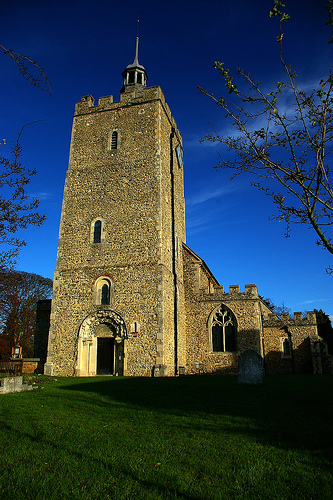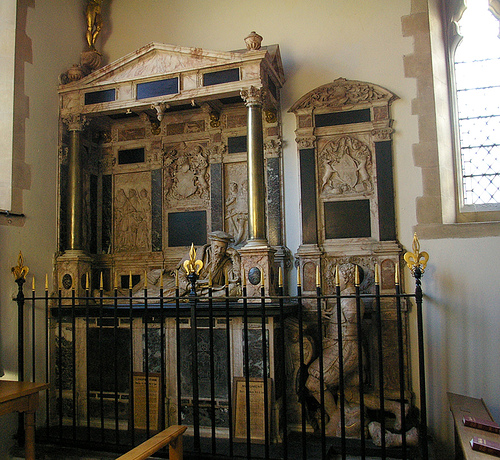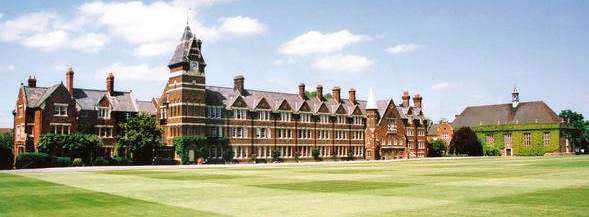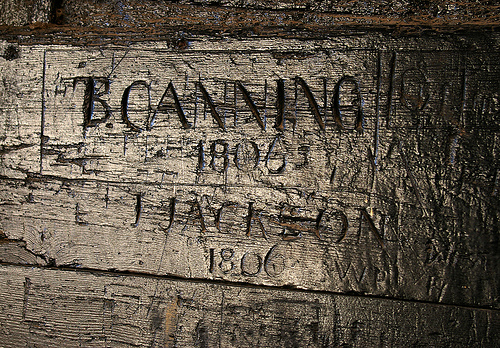March 2012: the six-month closure of the Church from October 2011 for refurbishment now looks as though it will continue for a few more months because of some interesting archæological findings and consequent investigations. The floor and heating boiler are being replaced, and the chancel “reordered” to provide access for disabled people. Meanwhile parish services are taking place in the Felsted School Chapel at N 51° 51.477' E 000° 26.097'.
For a pictorial update on the work in progress, see the Church's website.

Holy Cross Church
The Norman tower dates from 1120–1140, though its fabric includes Roman building materials. By about 1190, the west doorway and the south aisle had been added to the nave and chancel. The north aisle followed in about 1330. Originally starkly unadorned, both tower and church were later ‘improved’ by the addition of battlements and the ditzy 18th century cupola.
There have been many alterations and additions since, and more are now in progress. However the south porch, the Riche Chapel next to the Chancel, and the 14th century font — the bowl of which may be much older — are largely original.
More pictures in the gallery, below.
Richard Rich, 1st Baron Rich of Leez (1496–1567)
 |
 |
| ... portrayed by Hans Holbein |
... and on his memorial |
The Riche chapel was built between 1600 and 1617 by Robert Rich, 3rd Baron, in commemoration of his father Robert and his grandfather, Sir Richard Rich, respectively the 2nd and 1st Barons Rich (or Riche) of Leez. It houses a four-metre-high memorial, depicting Robert Sr kneeling before his reclining father. The sculpture is unsigned, but it has tentatively been attributed to Epiphanius Evesham.

The Riche Memorial
Sir Richard had assisted King Henry VIII in the dissolution of the Roman Catholic monasteries. As anyone familiar with Robert Bolt’s play and 1966 film ‘A Man for All Seasons’ will know, it was the — allegedly perjurious — testimony of Rich, portrayed in the film by a young John Hurt, which condemned Sir Thomas More (Lord Chancellor of England 1529–32) to be beheaded.
In 1536, Rich became Chancellor of the Court of Augmentation, responsible for dispersing the revenues and property of the dissolved monasteries. He acquired from among the spoils, either by grant or purchase, Leez (Leighs) Priory, a mile to the south of Felsted, together with about a hundred manors in Essex. In 1536 he was also briefly Speaker of the House of Commons, and later (1547–51) himself became Lord Chancellor of England.
Although a lifelong Roman Catholic, during the reigns of Henry VIII’s children Sir Richard was notably a supporter of whichever religion happened to be in power at the time. He was created Baron Rich (or Riche) of Leez in 1547 by the young King Edward VI. Following Edward’s death at the age of fifteen in July 1553, Rich briefly supported the accession of (Protestant) Lady Jane Grey, the 17-year-old ‘nine-day Queen’, but after her execution rapidly emerged as a prominent host and servant to the new (Catholic) Queen Mary I. He was enthusiastic in supporting the burning of Protestant martyrs ('heretics') in Essex in the Queen’s name. After the death of 'Bloody' Mary in 1558, however, he once more changed tack and, although retired from court, was appointed to accompany the new (Protestant) Queen Elizabeth I to London.
Felsted School
In May 1564, at the age of 68 and three years before his death, Rich made provision for a priest to become chaplain and schoolmaster in Felsted. He was to teach four score male children born in Essex “in lernyng of Grammer and other vertues and godly lernyng according to Christes religion”. Richard Rich and his descendants (later, the Earls of Warwick) acted as the governing body until 1851, when a new body was established by the Court of Chancery.

 The independent school is now Felsted's largest employer (and greatest creator of traffic congestion), owning 80 acres (32ha) of land and many of the most interesting buildings in the village centre. It has around 500 pupils — boys and girls 13 to 18 years old, mostly boarders paying £25,935 each per year — plus 400 Preparatory and pre-Preparatory pupils (age 4 to 12).
The independent school is now Felsted's largest employer (and greatest creator of traffic congestion), owning 80 acres (32ha) of land and many of the most interesting buildings in the village centre. It has around 500 pupils — boys and girls 13 to 18 years old, mostly boarders paying £25,935 each per year — plus 400 Preparatory and pre-Preparatory pupils (age 4 to 12).

The Old School
The school’s original home was the former Guildhall, in front of the Church, which had been made redundant by Henry VIII's suppression of the guilds.

Strikingly, there is a large amount of schoolboy graffiti (here dated 1806) carved into the wooden archway through the old school building, and also into the timbers of its back wall and into the limestone walls of the Riche Chapel.
The Clock and Bells
The inscription on the oldest of the peal of eight bells is dated 1628. However the peal was recast in 1914 and re-hung with new crowns in early 2009. The clock has its own bell, which is housed in the cupola and dates from 1546. The clock itself was made by John (‘Johannes’) Fordham of Great Dunmow in 1701. It is in full working order, but is currently stopped because there is no access to the winding mechanism — or the bells — during the current refurbishment.
You are welcome to add churches to this series. If you wish to do so, please let sadexploration know first so he can keep track of the church numbers and names to avoid duplication.